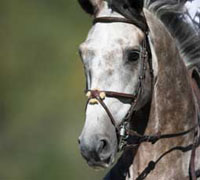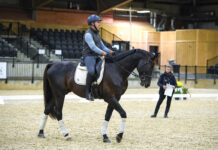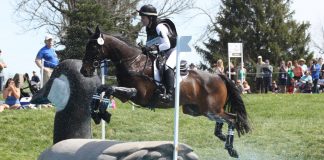 Q: I lease an older horse that’s a retired jumper. He’s a good boy but he holds his head really high. I spend lots of time on flatwork between my lessons and I’m good with my hands. Why does he still hold his head up? How can I get him to lower his head? I really don’t want to resort to draw reins or martingales.
Q: I lease an older horse that’s a retired jumper. He’s a good boy but he holds his head really high. I spend lots of time on flatwork between my lessons and I’m good with my hands. Why does he still hold his head up? How can I get him to lower his head? I really don’t want to resort to draw reins or martingales.
You can indeed help fix the problem between lessons without using artificial training devices. Providing your horse doesn’t suffer from a soundness issue, stick to your flatwork routine. First equip him in the mildest bit required to maintain control. Ideally that would be some sort of snaffle. Then utilize lots of patterns that incorporate lateral bends. Use lots of figure-eights, serpentines and simple half-turns. Ride deeply into every corner, asking him to bend in the proper direction. Press with your inside leg behind the girth so you have the sensation of pushing his energy onto your outside rein. You must be ready to reward any inch of compliance by pushing your inside hand forward toward his mouth, essentially “giving” him the bit. This slight relaxation of your hand encourages him to reach for the bit even further, which in turn will lower his headset.
As your gelding learns to supple his neck from left to right he’ll also begin to become supple vertically. That is, as he begins to bend and flex side to side, his neck will lengthen and his head will drop, too. Again, be prepared to reward his effort by softening your contact ever so slightly, even if it’s just for a few strides. Because your horse is older, and probably a little set in his ways, this program will take time. And he’ll probably never carry himself like a hunter under saddle. But if you’re consistent and patient, he’ll learn to relax, trust your hands, and lower his head.
–Cindy Hale
Ask your horse training questions on the HorseChannel.com Forums >>
See more Expert Q&As >>
Submit your Ask the Expert question >>







Great advice. I’ve ridden two horses that really had a problem with this. I used a running martingale on one with great success. The other just naturally held her head high and even hit me in the face a few times because of it. Each horse is so different.
Follow this advice, I have a gaited mare who held her head high (and tight) too. This same advice was given to me by my wise instructor who, if she can, also avoids such contraptions. It worked for her, she now relaxs into the bit.
I agre with the others, this article is good advice. Worth rereading.